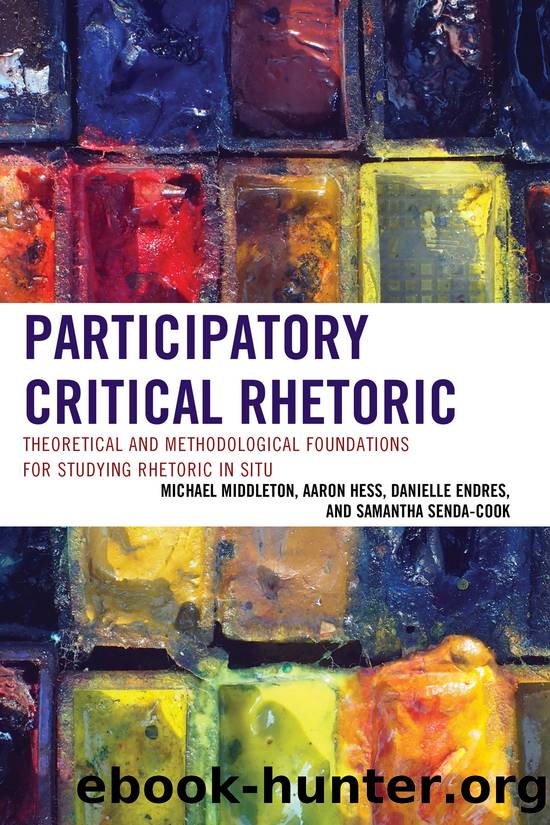Participatory Critical Rhetoric by Middleton Michael;Hess Aaron;Endres Danielle;Senda-Cook Samantha;

Author:Middleton, Michael;Hess, Aaron;Endres, Danielle;Senda-Cook, Samantha;
Language: eng
Format: epub
Publisher: Lexington Books
Chapter 5
Participants and Perspectives
At the tenth anniversary of September 11th, thousands of people flocked to Lower Manhattan to mourn, commemorate, and mark the occasion. Presidents, tourists, and New Yorkers gazed with anticipation as the National September 11 Memorialâthe official memorial for the events of 9/11âwas opened. The dual memorials stand in the footprints of the Twin Towers. Aptly named Reflecting Absence, the gaping holes create an odd opening in the New York City skyline. Critics also took to the memorial to judge and critique it, pondering its material and aesthetic significance. As I stood next to the memorial, rubbing my hands across the punched-through bronze, I took in as much of its symbolic significance as I could, including the water, trees, and aural elements. It felt contemplative, as it probably was intended.
Standing outside the exit of the memorial, I interviewed a number of people who also spoke of its significance. Many confirmed my own sense of the memorial; it was âpeaceful,â âcalming,â and even âa little Buddhist.â These judgments of the memorial lend credence to an interpretation leaning toward renewal.
As I continued to meet others, however, my view of the memorial changed significantly. They offered competing judgments about the symbolic elements and politics of the memorial that stood in contrast with many of those who attended the opening ceremony, and certainly with the ongoing narrative of 9/11.
One intervieweeâa survivor who escaped death from the North Tower ten years priorâspoke of the unmarked survivor tree at the memorial, which I had walked past multiple times without realizing its significance. She indicated that the memorial served the purpose of commemorating the dead, but not the living. âSurvivors are the forgotten of 9/11 and a lot of us have talked about this. We were not invited to the Memorial, we were not honored for 10 years, there is no survivor place, and this is as much of a survivor place than Iâve experienced in 10 years.â
Similarly, another interviewee juxtaposed the events of 9/11 with the politics of the anniversary. As a first responder, he expressed great concern about the nature of the memorial and its tourist enterprise. âYeah. The 9/11 memorial people, none of them have lived down here. None of them were at the Trade Center. None of them were in this church when the firemen, the cops, construction workers. Thinking back, guys were coming here crying their eyes out. Itâsâ¦I mean, itâs disgusting, the whole thing. Iâm not just blaming it on them. The whole nation has made it a money-making operation. The quote â9/11, Never Forgetâ is now a business. Itâs disgusting.â
âAaron
Moving into the field recognizes that rhetoric is an exchange between people. At its core, participatory critical rhetoric invites considerations of rhetoric as living and emergent, meaning that critics will inevitably interact with other people in their research. As we discuss in the previous chapters, participatory critical rhetoric problematizes not only the nature of the critic, but also the relationship critics form with participants during the production of rhetorical artifacts.
Download
This site does not store any files on its server. We only index and link to content provided by other sites. Please contact the content providers to delete copyright contents if any and email us, we'll remove relevant links or contents immediately.
Cecilia; Or, Memoirs of an Heiress — Volume 1 by Fanny Burney(32434)
Cecilia; Or, Memoirs of an Heiress — Volume 2 by Fanny Burney(31871)
Cecilia; Or, Memoirs of an Heiress — Volume 3 by Fanny Burney(31852)
The Lost Art of Listening by Michael P. Nichols(7406)
Asking the Right Questions: A Guide to Critical Thinking by M. Neil Browne & Stuart M. Keeley(5632)
We Need to Talk by Celeste Headlee(5542)
On Writing A Memoir of the Craft by Stephen King(4863)
Dialogue by Robert McKee(4321)
Pre-Suasion: A Revolutionary Way to Influence and Persuade by Robert Cialdini(4145)
I Have Something to Say: Mastering the Art of Public Speaking in an Age of Disconnection by John Bowe(3840)
Elements of Style 2017 by Richard De A'Morelli(3307)
The Book of Human Emotions by Tiffany Watt Smith(3238)
Fluent Forever: How to Learn Any Language Fast and Never Forget It by Gabriel Wyner(3028)
Name Book, The: Over 10,000 Names--Their Meanings, Origins, and Spiritual Significance by Astoria Dorothy(2939)
Good Humor, Bad Taste: A Sociology of the Joke by Kuipers Giselinde(2903)
Why I Write by George Orwell(2874)
The Art Of Deception by Kevin Mitnick(2736)
The Grammaring Guide to English Grammar with Exercises by Péter Simon(2706)
Ancient Worlds by Michael Scott(2623)
